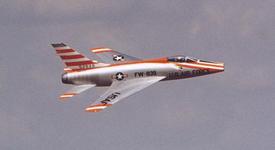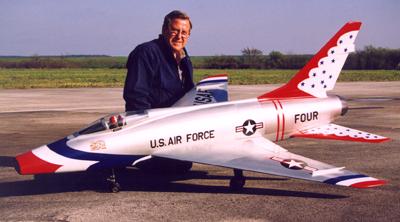 

High Speed and Aerobatic
test flights
accomplished June 22, 2000
Flight #4

 The atmospheric
conditions could not have been better, at 8am the sun was at our backs and
there was a slight southerly breeze, 3-5mph, right down the runway. The atmospheric
conditions could not have been better, at 8am the sun was at our backs and
there was a slight southerly breeze, 3-5mph, right down the runway.

 The purpose of this
flight was to check the model's airframe and control system worthiness at 200
mph. The purpose of this
flight was to check the model's airframe and control system worthiness at 200
mph.

 The takeoff was
accomplished using 15° of flaps and ½ deflection of the leading edge
slats. The engine was spooled up to 1/3rd throttle and then I released the
brakes, checked for a straight roll and then smoothly advanced the throttle to
100% power. After the flight we paced off the lift off point to be 200ft +or-
10ft from brake release. The model had a full load of fuel (4.8 Liters) and the
wings were clean (no tanks). The takeoff was
accomplished using 15° of flaps and ½ deflection of the leading edge
slats. The engine was spooled up to 1/3rd throttle and then I released the
brakes, checked for a straight roll and then smoothly advanced the throttle to
100% power. After the flight we paced off the lift off point to be 200ft +or-
10ft from brake release. The model had a full load of fuel (4.8 Liters) and the
wings were clean (no tanks).
  This kind of
performance will allow operation from 500ft paved model runways or 700' grass
strips. This kind of
performance will allow operation from 500ft paved model runways or 700' grass
strips.

 After a couple of trim
laps around the field and with the flaps and slats retracted, it was time to
put it to the test. Mitch Weiss handled the "Stalker Pro" radar gun, operating
it in the "Peak" mode - that means it saves the fastest speed recorded. After a couple of trim
laps around the field and with the flaps and slats retracted, it was time to
put it to the test. Mitch Weiss handled the "Stalker Pro" radar gun, operating
it in the "Peak" mode - that means it saves the fastest speed recorded.
 
 A halfhearted attempt
produced a speed of 178mph - the next run was 191, followed by 196. My goal was
to prove the F-100's worthiness at 200 so on the next run I put the power to
100% earlier in the slightly descending turn, leveled off at about 50 ft and
bore straight down the runway's outer edge. Mitch had an almost perfect head-on
shot with the radar gun, 212 mph was recorded as the F-100 and
its AMT AT-280 roared by still accelerating! I made a high G pull up and let it
climb. A halfhearted attempt
produced a speed of 178mph - the next run was 191, followed by 196. My goal was
to prove the F-100's worthiness at 200 so on the next run I put the power to
100% earlier in the slightly descending turn, leveled off at about 50 ft and
bore straight down the runway's outer edge. Mitch had an almost perfect head-on
shot with the radar gun, 212 mph was recorded as the F-100 and
its AMT AT-280 roared by still accelerating! I made a high G pull up and let it
climb.

 We had just proven that
the new BVM "Engineered for Success" slogan can be honorably applied to our
Super Sabre. We had just proven that
the new BVM "Engineered for Success" slogan can be honorably applied to our
Super Sabre.

 A lot of things have to
be right for a model of this size, weight and scale fidelity to exceed 200 mph
and live to fly again. A lot of things have to
be right for a model of this size, weight and scale fidelity to exceed 200 mph
and live to fly again.
  Since the
AMA has dictated a maximum limit of 200 mph for jets, we felt that we must
prove our new model to be safe at that speed plus a comfortable margin of
safety. Since the
AMA has dictated a maximum limit of 200 mph for jets, we felt that we must
prove our new model to be safe at that speed plus a comfortable margin of
safety.

 As the size, weight and
complexity of our models increase so does the need for everything to be just
right. The parts, plans and instructions that BVM will supply with the F-100
will be extremely accurate so that each customer's model and control rigging
can duplicate the prototype. As long as good and experienced modeling
techniques are applied to glue and screw the parts together and the necessary
time is devoted to making sure things are right, every F-100 kit we sell will
be successful. As the size, weight and
complexity of our models increase so does the need for everything to be just
right. The parts, plans and instructions that BVM will supply with the F-100
will be extremely accurate so that each customer's model and control rigging
can duplicate the prototype. As long as good and experienced modeling
techniques are applied to glue and screw the parts together and the necessary
time is devoted to making sure things are right, every F-100 kit we sell will
be successful.
Flight #5
  The radar gun was used again, but this time to determine that the
normal fly-by that included a slow roll or roll into a straight inverted flight
is performed at 150-160 mph. A pull up into an immelman turn or loop is
executed at about 170-180 mph. The radar gun was used again, but this time to determine that the
normal fly-by that included a slow roll or roll into a straight inverted flight
is performed at 150-160 mph. A pull up into an immelman turn or loop is
executed at about 170-180 mph.
  Axial rolls
and straight pull-ups are the essentials of any aerobatic routine and it
appears that the F-100 has what it takes to allow development of a scale-like
air show presentation. The approach speed, i.e. the turn to final was clocked
at 65-70 mph with full slats/flaps and speed brake deployed. Axial rolls
and straight pull-ups are the essentials of any aerobatic routine and it
appears that the F-100 has what it takes to allow development of a scale-like
air show presentation. The approach speed, i.e. the turn to final was clocked
at 65-70 mph with full slats/flaps and speed brake deployed.

 The final (wings level)
approach speed was gradually slowing from 65 mph down to 50 mph and a touchdown
at 45 mph. This is very similar to a BVM Phantom that we radar checked
recently. The final (wings level)
approach speed was gradually slowing from 65 mph down to 50 mph and a touchdown
at 45 mph. This is very similar to a BVM Phantom that we radar checked
recently.

 The approach technique
is very similar to the F-4 in that it is a "power on" affair. The F-100 will
hold a flare out a bit longer and allow you to ease the mains onto the runway
and hold the nose up for aerodynamic braking. If a short field landing is
required, preset the brakes. A touchdown and smooth roll out can be
accomplished in 300-400 ft. The approach technique
is very similar to the F-4 in that it is a "power on" affair. The F-100 will
hold a flare out a bit longer and allow you to ease the mains onto the runway
and hold the nose up for aerodynamic braking. If a short field landing is
required, preset the brakes. A touchdown and smooth roll out can be
accomplished in 300-400 ft.
Available flight time:

 The F-100 takes off with
4.8 Liters of fuel. To error on the safe side, our "brakes off" to "brakes on"
time was kept to 6 minutes for these initial flights. There was about 2 Liters
of fuel remaining after shutdown. For now, we have an extra 16oz (.47 Liters)
tank in the model that empties first, I call it our "start and taxi fuel". It
is certainly not a must but it will afford more ground time if you are at a jet
meet and must wait your turn to take off. The F-100 takes off with
4.8 Liters of fuel. To error on the safe side, our "brakes off" to "brakes on"
time was kept to 6 minutes for these initial flights. There was about 2 Liters
of fuel remaining after shutdown. For now, we have an extra 16oz (.47 Liters)
tank in the model that empties first, I call it our "start and taxi fuel". It
is certainly not a must but it will afford more ground time if you are at a jet
meet and must wait your turn to take off.

 The prototype will now
be used to allow us to totally document each part and complete the instructions
and plans. The prototype will now
be used to allow us to totally document each part and complete the instructions
and plans.

 A second airframe will
also be assembled to be sure that the prototype-to-production process is
accurate. A second airframe will
also be assembled to be sure that the prototype-to-production process is
accurate.

 The first jet event for
the F-100 will probably be the Heart of Ohio Jet Scramble on August 25-27 in
Columbus, Ohio. The first jet event for
the F-100 will probably be the Heart of Ohio Jet Scramble on August 25-27 in
Columbus, Ohio.
Acknowledgements and Thank You's

  Lynn
McCauley of Ft. Worth, Texas developed the F-100 D that evolved into this BVM
kit. He was extremely knowledgeable of and experienced with the components that
add up to a good flying model. Lynn
McCauley of Ft. Worth, Texas developed the F-100 D that evolved into this BVM
kit. He was extremely knowledgeable of and experienced with the components that
add up to a good flying model.
  Thanks to
Jim Wiegle and the entire staff at AMT U.S.A. for the power system support and
the use of the radar gun. Thanks to
Jim Wiegle and the entire staff at AMT U.S.A. for the power system support and
the use of the radar gun.
  Thanks to the great people at Horizon Hobby who sell and support the
JR radio systems. There were some special challenges with this jet. F-100
customers will benefit from their help and receive a flight data sheet
reflecting the final set up in the prototype. It can also be emailed and
downloaded from a PC. Thanks to the great people at Horizon Hobby who sell and support the
JR radio systems. There were some special challenges with this jet. F-100
customers will benefit from their help and receive a flight data sheet
reflecting the final set up in the prototype. It can also be emailed and
downloaded from a PC.
  As many of
you know, we have a great staff here at BVM. I thank them for the extra effort
that it takes to make a project like this happen - it was a team
effort. As many of
you know, we have a great staff here at BVM. I thank them for the extra effort
that it takes to make a project like this happen - it was a team
effort.
"Engineered for Success" - It's easy to say - not so easy to
accomplish.
Bob Violett
More
info on the F-100D
The
initial flights of the F-100D

Contact Us
All graphics, photos, and text
Copyright 2016 BVM, Inc.
Use of graphics or photos without written permission from
BVM is
strictly prohibited. |